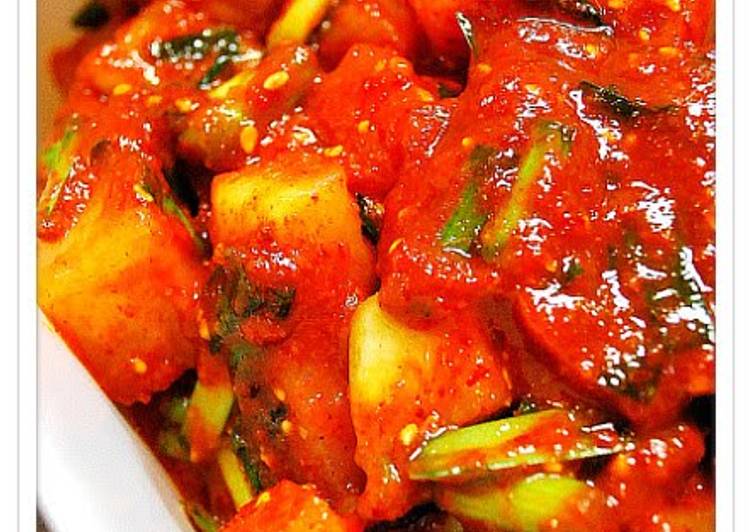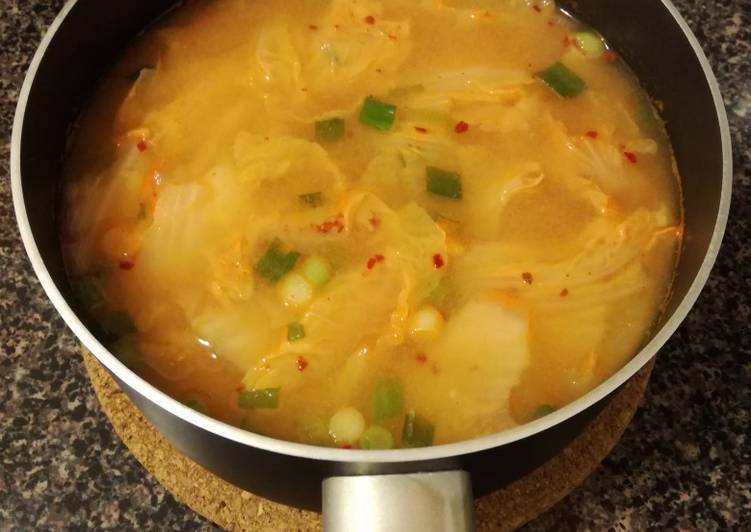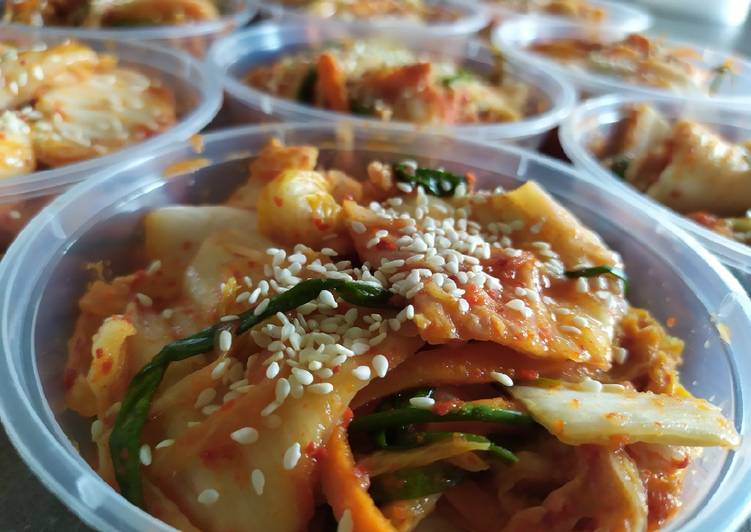
Hello everybody, it is Louise, welcome to my recipe page. Today, I’m gonna show you how to prepare a distinctive dish, kkakdugi (cubed radish kimchi). One of my favorites food recipes. This time, I’m gonna make it a bit unique. This is gonna smell and look delicious.
Daikon radish, fish sauce, garlic, ginger, green onion, hot pepper flakes, korean radish, salt, sugar. Kkakdugi (깍두기) is a kimchi made with Korean radish, mu (or moo, 무). It's an easy kimchi to make!
Kkakdugi (Cubed Radish Kimchi) is one of the most popular of current trending foods on earth. It is appreciated by millions daily. It is easy, it’s fast, it tastes delicious. Kkakdugi (Cubed Radish Kimchi) is something which I have loved my entire life. They’re nice and they look fantastic.
To get started with this particular recipe, we must prepare a few components. You can cook kkakdugi (cubed radish kimchi) using 21 ingredients and 19 steps. Here is how you cook it.
The ingredients needed to make Kkakdugi (Cubed Radish Kimchi):
- Prepare 1 Daikon radish
- Prepare 16 grams Salt
- Prepare 15 ★ Small dried sardines (niboshi)
- Get 2 pieces ★ Kombu
- Get 1000 ml ★ Water
- Get 160 grams ▼ Rice
- Take 23 grams ▼ Dashi soup stock
- Prepare 100 grams ◆ Onions
- Take 53 grams ◆ Garlic
- Prepare 30 grams ◆ Ginger
- Prepare 5 ◆ Korean red chili peppers (red)
- Make ready 90 grams ◆ Japanese plum extract
- Get 60 grams ◆ Sardine extract
- Prepare 30 grams ◆ Fermented krill
- Take 50 grams ◎ Korean red chili powder (for kimchi)
- Prepare 50 grams ◎ Red chili powder (seasoning)
- Take 1/2 bunch ☆ Green onions
- Take 1/2 bunch ☆ Chinese chives
- Prepare 30 grams Sugar
- Make ready 12 grams Salt
- Take 30 grams Toasted sesame seeds
Many Koreans say Kkakdugi made in mid to late autumn (October to December) tastes best as it is. Kkakdugi - Korean Cubed Radish Kimchi. So, if you have never made The size of the radish cubes for Kkakdugi comes in all different sizes. Kkakdugi (깍두기) or diced radish kimchi is a variety of kimchi in Korean cuisine.
Steps to make Kkakdugi (Cubed Radish Kimchi):
- Thoroughly rinse the daikon radish, and peel the skin with a peeler. Set aside the stalk end and root end. Do not discard.
- Chop the daikon radish into 2 cm rounds, dice them into 2 cm square cubes, then place them in a large bowl. Set aside the triangular shaped pieces.
- While chopping the daikon into cubes, place the ★ ingredients, the triangular shaped daikon pieces and the root end into a large pot with water to prepare the broth.
- Thoroughly rinse the stalk end, and cut the undamaged leaves into 2 cm lengths.
- Combine the cubed daikon and the leaves, add salt, lightly toss, and let sit for 1 hour. Do not rub the salt in.
- After 30 minutes, gently toss to evenly distribute the salt. Do not rub the salt in.
- Turn on the heat under the pot from Step 3, reduce it to medium-low heat after bringing it to a boil, then simmer for 30 minutes to make the broth. Do not let it boil.
- After about 1 hour, thoroughly drain the daikon and leaves from Step 6.
- After the broth is finished, prepare the yangnyeom. Put the rice in a bowl, pour in the hot broth, then process with a hand mixer.
- Process the rice and broth from Step 9 into a thick paste-like porridge, and transfer it to a large bowl.
- Prepare the ◆ ingredients to add to the porridge from Step 10. Remove the seeds from the red chili peppers, then roughly chop them with the onion, garlic, and ginger to make them easy to process, then add them to the porridge.
- Pulse the porridge with the added ingredients, check to make sure that the red chili peppers are finely processed, then turn off the mixer.
- You should be able to buy the Japanese plum extract at a Korean specialty shop. You could also substitute it with sweet syrup or a mild honey, but you will need to adjust the amount of sugar that you add.
- Add the plum extract to the porridge from Step 12, mix well, let it sit for 10 minutes, then stir again. Then the yangnyeom is ready.
- Place the daikon and leaves from Step 8 into a bowl, chop the ☆ ingredients into 2 cm lengths, add them with 250 g of the yangnyeom from Step 14, and evenly combine.
- Gradually mix in the sugar and the salt, and season to taste.
- Add the toasted sesame seeds and mix.
- It's done! Enjoy the three distinct flavors of freshly pickled kkakdugi, marinated kkakdugi, and sweetly acidic kkakdugi
- Store it in a Tupperware container with a lid, let it sit for a day at room temperature, then store it in the refrigerator from the next day onwards.
Usually, it has all the ingredients of kimchi, but the baechu (hangul: 배추; Napa cabbage) used for kimchi is replaced with Korean radish (called mu, 무 in Korean). Who can resist the crunch, refreshing, and perfectly fermented Korean radish kimchi called "Kkakdugi"? Put the kkakdugi into a glass jar and press down on the top of it to remove any air from between the radish cubes. Crunchy cubes of korean radish pickled in a spicy mixture of chili flakes, scallions, ginger and salted brine shrimp. Kkakdugi is a popular kimchi paired with Kimchi comes in all shapes and sizes, but this Kkakdugi (깍두기) made with large Korean radish is a perennial favorite.
So that is going to wrap it up for this special food kkakdugi (cubed radish kimchi) recipe. Thank you very much for your time. I am confident you will make this at home. There is gonna be interesting food at home recipes coming up. Remember to bookmark this page in your browser, and share it to your loved ones, friends and colleague. Thank you for reading. Go on get cooking!


